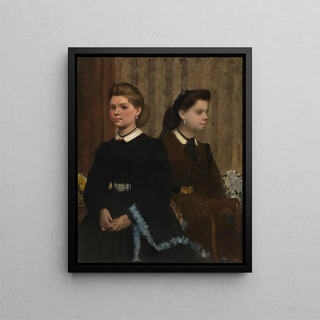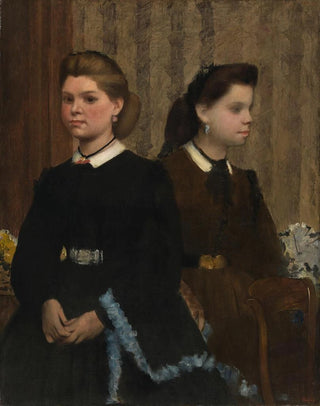Art print | The Bellelli Sisters Giovanna and Giuliana Bellelli - Edgar Degas


View from behind

Frame (optional)
In the world of art, some works transcend the simple frame of painting to become windows into eras, emotions, and stories. "The Bellelli Sisters Giovanna and Giuliana Bellelli" by Edgar Degas is one of those iconic creations that capture the very essence of 19th-century family life. This intimate portrayal of two young girls, frozen in a moment of tenderness and complicity, invites us to delve into the delicate and complex universe of childhood. Through this piece, Degas does not merely depict human figures; he evokes an atmosphere, a mood, a story that still resonates today.
Style and uniqueness of the work
Degas's style is often characterized by a blend of realism and impressionism, and "The Bellelli Sisters" is no exception. The composition is carefully orchestrated, with particular attention paid to the posture and expressions of the two sisters. The colors, though soft, are enhanced by subtle contrasts that bring the characters to life. Light plays a crucial role, illuminating the faces of the young girls while creating delicate shadows that add depth to the scene. Degas, true to his approach, captures not only the appearance of the sisters but also their essence, their emotions, and their bond. The way he uses space and perspective demonstrates his artistic genius, making this work unique and profoundly moving.
The artist and his influence
Edgar Degas, an emblematic figure of the Impressionist movement, knew how to mark his era with his innovative vision and bold approach to painting. Born in Paris in 1834, he developed a distinctive style that blends tradition and modernity. Although often associated with dance and ballet scenes, his work encompasses a multitude of subjects, including portraits and scenes of everyday life. "The Bellelli Sisters" is a perfect example of his talent for capturing fleeting moments with emotional depth. Degas's influence is felt not only in his time but also in contemporary art, where many artists continue to explore themes of light,

Matte finish

View from behind

Frame (optional)
In the world of art, some works transcend the simple frame of painting to become windows into eras, emotions, and stories. "The Bellelli Sisters Giovanna and Giuliana Bellelli" by Edgar Degas is one of those iconic creations that capture the very essence of 19th-century family life. This intimate portrayal of two young girls, frozen in a moment of tenderness and complicity, invites us to delve into the delicate and complex universe of childhood. Through this piece, Degas does not merely depict human figures; he evokes an atmosphere, a mood, a story that still resonates today.
Style and uniqueness of the work
Degas's style is often characterized by a blend of realism and impressionism, and "The Bellelli Sisters" is no exception. The composition is carefully orchestrated, with particular attention paid to the posture and expressions of the two sisters. The colors, though soft, are enhanced by subtle contrasts that bring the characters to life. Light plays a crucial role, illuminating the faces of the young girls while creating delicate shadows that add depth to the scene. Degas, true to his approach, captures not only the appearance of the sisters but also their essence, their emotions, and their bond. The way he uses space and perspective demonstrates his artistic genius, making this work unique and profoundly moving.
The artist and his influence
Edgar Degas, an emblematic figure of the Impressionist movement, knew how to mark his era with his innovative vision and bold approach to painting. Born in Paris in 1834, he developed a distinctive style that blends tradition and modernity. Although often associated with dance and ballet scenes, his work encompasses a multitude of subjects, including portraits and scenes of everyday life. "The Bellelli Sisters" is a perfect example of his talent for capturing fleeting moments with emotional depth. Degas's influence is felt not only in his time but also in contemporary art, where many artists continue to explore themes of light,






